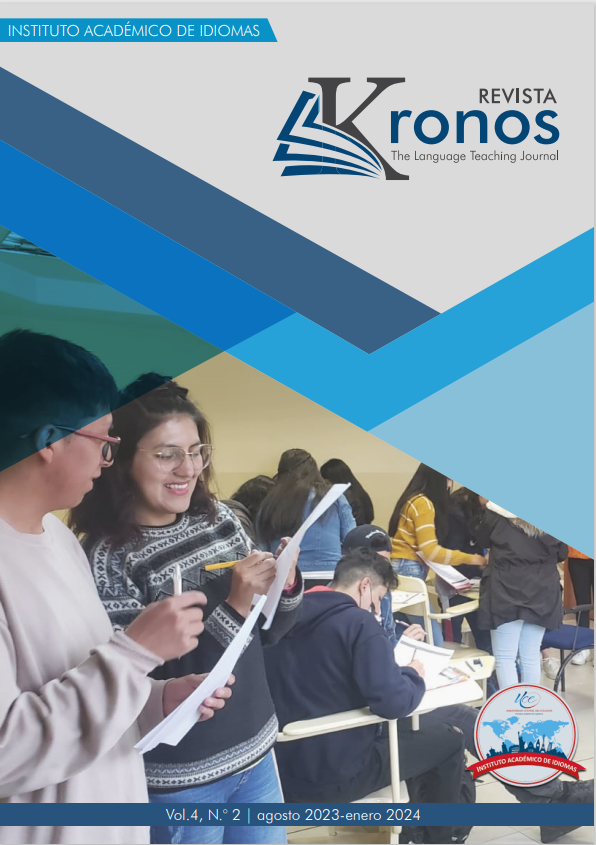The influence of Comics in the acquisition of the English Language during post pandemic period
DOI:
https://doi.org/10.29166/kronos.v4i2.4773Keywords:
Comic strips, acquisition of a language, benefits, challengesAbstract
The coronavirus had produced changes in lifestyles and the virus has become a part and parcel of our daily lives, especially for students. With new teaching practices undertaken, new reforms are being made for students in high schools. This paper presents insights into the changing learning habits of Ecuadorian students. Recent studies have argued the use of comic strips in language teaching is a helpful tool in the acquisition of a target language during the post-pandemic situation. The present study will elaborate on the use of comic strips as a medium of learning, its benefits, and the challenges in its implementation. The investigation was carried out in a private school in one of the biggest cities of Ecuador with 50 participants. The findings are based on the results of surveys and articles related to the implementation of comic strips for language teaching after the pandemic period.
Downloads
References
Allen, K., & Ingulsrud, E. (2003). Manga literacy: Popular culture and the reading habits of Japanese college students. Journal of Adolescent & Adult Literacy, 46(8), 674-683.
Budiman, P. G., Sada, C., & Wardah. (2018). Improving students vocabulary by using comic strips in teaching narrative text. Jurnal Pendidikan Dan Pembelajaran Khatu listiwa, 7(9), 1-8. Retrieved from https://jurnal.untan.ac.id/index.php/jpdpb/article/download/28279/75676578327
Cabrera, P., Castillo, L., González, P., Quiñónez, A., & Ochoa, C. (2018). The impact of using Pixton for teaching grammar and vocabulary in the efl Ecuadorian context. Teaching English with Technology, 18(1), 53-76. Retrieved from http://cejsh.icm.edu.pl/cejsh/element/bwmeta1.element.desklight-65acf8b1-db70-4a7a-9a8c-88af c73583a3/c/ARTICLE4.pdf
Cabrera, P., Castillo, L., González, P., Quiñónez, A., & Ochoa, C. (2018). The impact of using Pixton for teaching grammar and vocabulary in the efl Ecuadorian context. Teaching English with Technology, 18(1), 53-76. Retrieved from http://cejsh.icm.edu.pl/cejsh/element/bwmeta1.element.desklight-65acf8b1-db70-4a7a9a8c-88afc73583a3/c/ARTICLE4.pdf
Chaikovska, O. (2018). Benefits of teaching esl through comic strips. Web of Scholar, 4(1), 8-11. Retrieved from https://www.academia.edu/37665857/BENEFITS_OF_TEACHING_ESL_THROUGH_COMIC_STRIPS
Cambridge (2016). Principles of Good Practices: Research and innovation in language learning and assessment. Cambridge English Language assessment, 1-36.
Fischer, J. (2012). Using innovative teaching techniques and technological tools to teach grammar points in Spanish and how they increase student engagement. International Journal for Cross-Disciplinary Subjects in Education (ijcdse), 2(2), 1025-1028. Retrieved from https://infonomics-society.org/wp-content/uploads/ijcdse/published-papers/special-issue-volume-2-2012/Using-Innovative-Teaching-Techniques-and-Technological-Tools-to-Teach-Grammar-Points-in-Spanish-and-How-They-Increase-Stu dent-Engagement.pdf DOI: https://doi.org/10.20533/ijcdse.2042.6364.2012.0145
Furstenberg, G. (1997). Teaching with technology: What is at stake. adfl Bulletin, 28(3), 21-25. DOI: https://doi.org/10.1632/adfl.28.3.21
Flores, M. A., & Gago, M. (2020). Teacher Education in Times of Covid-19 Pandemic in Portugal: National, Institutional and Pedagogical Responses. Journal of Education for Teaching, 46(4), 507-516. DOI: https://doi.org/10.1080/02607476.2020.1799709
García Sánchez, J. E., & García Sánchez, E. (2020). La microbiología médica y las enfer medades infecciosas en el cómic. Revista de Medicina y Cine, 16(1), 53-54. DOI: https://doi.org/10.14201/rmc20201615354
Guerra-Zúñiga, M., & Segovia-Chamorro, J. (2020). Uso de cómics para la formación médica en contenidos de migraciones internacionales y salud. fem: Revista de la Fundación Educación Médica, 23(4), 199-204. DOI: https://doi.org/10.33588/fem.234.1065
Hasanah, Y. A. (2021). Situating Character Based Learning of Anti-Corruption Through Digital Comics in Teaching English. jetli: Journal of English Teaching and Linguistics, 2(1), 1-9. https://ejournal.unida-aceh.ac.id/index.php/jetli/article/view/19 DOI: https://doi.org/10.55616/jetli.v2i1.19
Jacobs, D. (2013). Graphic Encounter: Comics and The Sponsorship of Multimodal Literacy. Bloomsbury Academic.
Kohnke, L. (2018). Using comic strips to stimulate student creativity in language learning.
tesol Journal, 10(2), 419-423. Retrieved from https://doi.org/10.1002/tesj.419 DOI: https://doi.org/10.1002/tesj.419
Lalanda, M. (2019). El cómic como herramienta en el mundo sanitario. DOI: https://doi.org/10.24197/cl.27.2019.56-66
Mayor Serrano, M. B. (2021). Divulgación científica a través del lenguaje del cómic: la covid-19. DOI: https://doi.org/10.14201/rmc202016e6979
McCloud, S. (1995). Cómo se hace un cómic: el arte invisible. Ediciones B.
Megawati, F., & Anugerahwati, M. (2012). Comic strips: A Study on the teaching of writing narrative texts to Indonesian efl students. teflin Journal, 23(2), 183-205. https://doi.org/http://dx.doi.org/10.15639/teflinjournal.v23i2/183-205
Published
How to Cite
Issue
Section
License
Copyright (c) 2023 Erika Patricia Tenezaca Yadaicela, Paula Cisneros Rosero, Mateo Solórzano Hernández, Gabriela Escobar Trujillo, Nicolás Barriga Porras

This work is licensed under a Creative Commons Attribution-NonCommercial-ShareAlike 4.0 International License.












